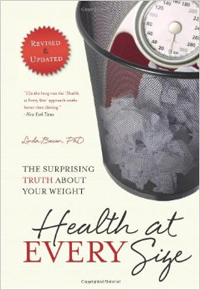 I recently read a book called Health at Every Size: The Surprising Truth About Your Weight by nutrition professor and researcher Linda Bacon. Before reading it, I looked at the website and thought I knew what to expect. I assumed the book would remind me to love myself, to put less emphasis on physical beauty and to focus instead on healthy living. I was partly right, but ultimately I was surprised and impressed by how much more the book taught me.
I recently read a book called Health at Every Size: The Surprising Truth About Your Weight by nutrition professor and researcher Linda Bacon. Before reading it, I looked at the website and thought I knew what to expect. I assumed the book would remind me to love myself, to put less emphasis on physical beauty and to focus instead on healthy living. I was partly right, but ultimately I was surprised and impressed by how much more the book taught me.
Think about the concept of Alliesthesia. Alliesthesia refers to the idea that a body’s inner state determines whether an external experience is pleasurable. One example is that it feels better to get into a hot tub when your body feels cold. If you’re a menopausal woman in the middle of a hot flash, the last thing you want to do is step into a hot tub.
 In regard to food and eating, Health at Every Size taught me about “Negative alliesthesia.” Negative alliesthesia is an unavoidable process in which your taste buds find a flavor less pleasant over time after repeated exposure. It’s “nature’s way of prompting you to eat less once your calorie needs are met.” This explains why the first two potato chips taste better, as does the first bite of an apple. The last forkful of cake is never as divine as the first. Negative alliesthesia is the body’s wisdom at work, telling you, “You’ve had enough.”
In regard to food and eating, Health at Every Size taught me about “Negative alliesthesia.” Negative alliesthesia is an unavoidable process in which your taste buds find a flavor less pleasant over time after repeated exposure. It’s “nature’s way of prompting you to eat less once your calorie needs are met.” This explains why the first two potato chips taste better, as does the first bite of an apple. The last forkful of cake is never as divine as the first. Negative alliesthesia is the body’s wisdom at work, telling you, “You’ve had enough.”
If your body’s signals are weak or you’ve lost your ability to tune into those signals, you’ll chase the pleasure of the first bite by eating more and more and more. The more out of touch you are with your body, the more likely you are to eat in a way that feels mechanical, driven, and compulsive.
Jean Fain, a mindfulness expert and licensed psychotherapist, says, “Truth be told, most of us achieve a natural trance state when we eat mindlessly. ‘Trance eating,’ in my view, is the extreme end of the mindless eating spectrum.”
She’s right. Trance eaters often push for quantity instead of quality, which results in excessive fullness and discomfort, followed by a feeling of dissatisfaction. The experience is a mindless one. People seek the initial “especially good” flavor of the first few bites by taking endlessly more bites or by pushing for larger quantities.
For healthier eating, the trick is to focus on the first few bites and enjoy the experience of taste and quality. When the body tells you it’s full by sending a “meh” signal to your taste buds, you listen and you stop eating. It sounds simple, but if you’ve lost touch with your body, it requires practice.
Alongside teaching about alliesthesia, Health At Every Size educates readers about creating better ways of enjoying oneself and existing in the world. The book points out how often people tell themselves, “I’ll be happy once I’m thin,” or “I’ll feel confident if I lose that last 10 pounds.” So many people are waiting to be happy, waiting for their lives to start.
Often, people worry that if they accept themselves physically, they’ll never be motivated to be healthy. They believe they’ll be fat and ugly and complacent. They believe that self-hate creates boundaries and keeps them safe. But self-hate just results in misery. Health At Any Size says, “Start living life fully now, in your present body, because waiting until you lose weight is a big old waste of time.” The idea is this: Ask not, How can I get thin? Instead ask, What can I do to be happier?
There are two unhealthy ends of the spectrum here: There are trance eaters, who are tuned out, mindlessly unhappy. There are strivers, who are so tuned in to perfectionistic, rigid ideas about food and goal-weight that they’re too mindful, and mindfully miserable.
The middle ground is to tune into your body while relaxing into it as well, to be aware and to be accepting. We are not powerless. In fact, Linda Bacon says, “The single most powerful act available to you is to own your body—to walk proud and let others see you enjoying your body.” Happiness, health, and self-acceptance are within reach, and Health At Any Size reminds us of that.
If you’re interested to know more about the Health At Every Size movement, you can find more information here: haescommunity.org
Post Disclaimer
This content is for informational purposes only and does not constitute medical advice. Please consult a healthcare professional for any medical concerns.



1 Comment
Elaine Mansfield
Wonderful article, Pamela. A good way to consider mindful and mindless eating and living. I first experienced “trance eating”–a great name for it–when my dad died when I was fourteen. I wanted to be numb. I wasn’t bulimic and didn’t become obese, but I was at constant war with my body and appetites. I struggled with this coping mechanism much of my adult life. I was sure I had it licked about 16 years ago, and I did for almost ten years. Then my husband died. That old strategy was waiting to help me numb my grief. I ate healthy meals, but alone at night, I wanted more. I wanted lethargy and sleep. Grievers often either eat too little or eat too much. The instinctual wisdom gets thrown off, but no excuses for me now. I experienced living in harmony with my appetites. It was the best antidepressant ever.